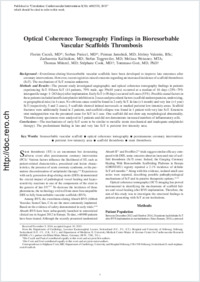Optical coherence tomography findings in bioresorbable vascular scaffolds thrombosis
- Cuculi, Florim Department of Cardiology, Luzerner Kantonsspital, Luzern, Switzerland
- Puricel, Serban Hospital and University of Fribourg, Fribourg, Switzerland
- Jamshidi, Peiman Department of Cardiology, Luzerner Kantonsspital, Luzern, Switzerland
- Valentin, Jérémy Hospital and University of Fribourg, Fribourg, Switzerland
- Kallinikou, Zacharenia Hospital and University of Fribourg, Fribourg, Switzerland
- Toggweiler, Stefan Department of Cardiology, Luzerner Kantonsspital, Luzern, Switzerland
- Weissner, Melissa Department of Medicine II, University Medical Center Mainz, Germany
- Münzel, Thomas Department of Medicine II, University Medical Center Mainz, Germany
- Cook, Stéphane Hospital and University of Fribourg, Fribourg, Switzerland
- Gori, Tommaso Department of Medicine II, University Medical Center Mainz, Germany
-
10.01.2015
Published in:
- Circulation: Cardiovascular Interventions. - 2015, vol. 8, no. 10, p. e002518
English
Background—Everolimus-eluting bioresorbable vascular scaffolds have been developed to improve late outcomes after coronary interventions. However, recent registries raised concerns regarding an increased incidence of scaffold thrombosis (ScT). The mechanism of ScT remains unknown.Methods and Results—The present study investigated angiographic and optical coherence tomography findings in patients experiencing ScT. Fifteen ScT (14 patients, 79% male, age 59±10 years) occurred at a median of 16 days (25%–75% interquartile range: 1–263 days) after implantation. Early ScT (<30 days) occurred in 8 cases (53%). Possible causal factors in these patients included insufficient platelet inhibition in 2 cases and procedural factors (scaffold underexpansion, undersizing, or geographical miss) in 4 cases. No obvious cause could be found in 2 early ScT. In late (>1 month) and very late (>1 year) ScT (respectively, 5 and 2 cases), 5 scaffolds showed intimal neovessels or marked peristrut low-intensity areas. Scaffold fractures were additionally found in 2 patients, and scaffold collapse was found in 1 patient with very late ScT. Extensive strut malapposition was the presumed cause for ScT in 1 case. One scaffold did not show any morphological abnormality. Thrombectomy specimens were analyzed in 3 patients and did not demonstrate increased numbers of inflammatory cells.Conclusions—The mechanisms of early ScT seem to be similar to metallic stents (mechanical and inadequate antiplatelet therapy). The predominant finding in late and very late ScT is peristrut low-intensity area.
- Faculty
- Faculté des sciences et de médecine
- Department
- Médecine 3ème année
- Language
-
- English
- Classification
- Medicine
- License
- License undefined
- Identifiers
-
- RERO DOC 258006
- DOI 10.1161/CIRCINTERVENTIONS.114.002518
- Persistent URL
- https://folia.unifr.ch/unifr/documents/304654
Statistics
Document views: 117
File downloads:
- coo_oct.pdf: 150
